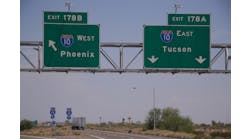By: Dan McNichol
The Chinese believe in the power of one: one people, one party, one government. It makes sense that the great civil projects that have come to symbolize China are singular in tone regardless of their scope. The Grand Canal is actually a complex system of hundreds of miles of many separate canals. The Great Wall is not one wall but many walls. The Silk Road was a road network of numerous trade routes.
In the spirit of its past projects, perhaps China’s many new expressways and modern turnpikes also will be lumped into one with a name such as the Great Expressway or the Grand Turnpike.
Whatever name Chinese historians bestow on their massive new expressway projects, make no mistake, China’s superhighways will be seen as one great system.
Skeleton’s key
The official name for China’s new national network of superexpressways has an awkward translation: National Highway Skeleton Net. Some world trade organizations reference the system as the National Trunk Highway System. More to the point—and with respect to China’s role model here, the U.S. Interstate System—the massive engineering program in this article will be called China’s Interprovince Expressway System.
If imitation is the highest form of compliment, Americans should feel flattered. China’s Interprovince Expressway System follows the planning, designing, building and administrative models of the U.S. Interstate System. China’s central government plays a heavy role in the planning and funding of the routes. The 30-odd provinces, similar to our states, also play a critical role in deciding which roads are built and where. Capital cities are of primary importance and are intentionally connected to the expressway system. Commercial priorities are central to the new system’s design: Airports, seaports and train stations are being connected for the first time. As on the U.S. Interstate System, the Chinese military has the ultimate right-of-way on the Interprovince Expressway System.
Like the U.S. Interstate System has bound this nation, the Interprovince Expressway System has deepened the unification of China’s provinces by connecting its provincial capital cities with one another.
Economic opportunities have arrived and continue to pour into the poorest, most remote regions of China by way of the expressway system. Provinces are now connected by one day of car or truck travel—an unthinkable notion less than a generation ago. Slogans celebrating expressway travel boast about how quickly a traveler can move from one end of a metropolis to the other. For example, in Beijing a road slogan proclaims, “As we approach the Olympics, let’s realize a maximum one-hour trip to anywhere within Beijing.”
No curbing the crave
It is difficult for any outsider to comprehend the magnitude of this historic civil engineering achievement. In 1992, when it was decided in China that one national system of expressways was to be launched, the ambitious goal of 35,000 km of new four-lane routes was planned. At the time there were practically no other superhighways in the country except in the city of Shanghai. By 1997 China was spending $13 billion in expressway construction. The following year, just as the Asian financial crisis was threatening the continent, China boldly more than doubled its expressway spending to $30 billion.
An aggressive but achievable completion date of 2020 was set. By 2002, the Interprovince Expressway System was ahead of schedule with 77% of the work completed. Today, the original goal appears to have been met—putting the job 18 years ahead of schedule. Just last year 12 new expressways opened for service. There are now over 41,000 km of expressway routes in China, giving it one of the highest number of superhighway miles in the world.
Having overachieved its goals, new sights have been set. The new grand plans are lofty. By 2030, China plans on expanding its Interprovince Expressway System another 51,000 km. The budget will be an astounding 2 trillion yuan, or about $250 billion. The total length of expressways will reach 92,000 km. China’s economy has become dependent on its expressways. China’s future growth and prosperity depend on its expressway construction and maintenance to modernize the nation in ways similar to the Interstate System’s modernization of the U.S.
Ten short years ago, China had the fewest motor vehicles in the world per capita with just one vehicle for every 186 citizens. Compounding China’s underdeveloped status was the fact that many of those motor vehicles were buses. At the other extreme, the U.S. had the most motor vehicles per person of any nation on earth—one automobile for every two people. Between 1994 and 2004 China’s automobile ratio doubled, and today it is one of the world’s largest manufacturers of automobiles. The People’s Daily reported, “China’s auto industry has grown so rapidly in the five years since the nation joined the World Trade Organization that it will soon become the world’s third-largest auto manufacturer, behind the United States and Japan.”
Building up China’s Interprovince Expressway System has reduced poverty, increased the standard of living and shifted China from an agriculture-based economy to one of manufacturing.
As recently as 1982, China’s economy was about equal to India’s. Both nations saw their few good highways covered with pedestrians, bicyclists, livestock, large overloaded trucks and small underpowered vehicles. Besides the chaos and dangers, infamous traffic jams on nearly every highway became laggards on the two economies. Then, a near-miracle unfolded as China launched the seemingly instantaneous construction of thousands of miles of world-class superhighways. In a single decade China left India in the dust, its economy having grown to nearly three times the size.
Everywhere Americans traveled between 1956 and 1966, they witnessed the construction of the Interstate System, which was reaching the peak of its construction. The Chinese saw a similar accomplishment in the decade between 1992 and 2002. In 1992 China decided to begin building its highway infrastructure from the top down. In other words, China’s road-building policy was first and foremost about building expressways. Small roadway improvements were secondary. However, a policy based on superstructures that delivered greater travel capacity than would at first be absorbed was politically risky, not to mention physically ambitious, especially in a nation struggling to provide simple farm-to-market roads for its predominantly rural populations.
Railroading the system
Realizing that highway construction requires large dollar amounts and an enormous professional work force to design, build and administrate, China set out to create the know-how. Using its expertise in railroad construction, the central government pulled qualified contractors into the world of expressway construction, broadening their road-building networks. Today there are over 240 entities that are capable of designing highways and 79 agencies that are qualified for the highest level of road design: expressway design. This means nationally there are over 60,000 capable highway engineers. The Chinese also are living the reality that rapid growth cannot be sustained without consistent and substantial investments.
The introduction of low bidding in China, a prerequisite of some earlier World Bank projects starting in 1985, has moved the road-building industry from one of a centralized and bureaucratic system of in-house construction agencies to one of independent contractors and lower bids. As the World Bank said, China’s “competitive market-based economy is still a work in progress.” Not long ago, every road-building construction firm was part of a highway authority. Low bidding has reduced the costs of expressway construction and accelerated their completion.
Payment plan
Toll gates in China are common. In the Kansas-sized Guandong Province alone, there are over 300 tollways. Reducing the number of these congestion-inducing and costly facilities could be done by imposing a tax on fuels. However, the central tolls have been the chosen source of revenue and means of debt service. Since most of the construction money comes from government loans that require repayment, tolls are needed on every new route. The problem is that without the high traffic counts of a fully developed nation—there are far fewer cars in China than the U.S., and there were nearly none just 20 years ago—it has been hard to generate road-building revenues with just tolls.
Tolling has only been able to produce about a fourth of the money needed. Aware of this, the government authorized the implementation of a fuel tax in 1998, but no agreement on how to collect money materialized. Opposing a fuel tax were farmers who collectively purchase vast amounts of fuel but do not use the modern expressways—at least not with their tractors. However, without a fuel tax, more tolls and higher fees are going to be in China’s future.
“There are two types of highways in China,” an official who did not wish to be identified explained. One type is “government-built expressways, which are 100% owned by the central and/or provincial governments. These are able to collect tolls for 50 years at most. The other type is a company-built expressway, which is owned by a mixture of government and private companies. These companies might be foreign companies that partake in the financing through joint ventures. They have only 25 years to do their tolling before the booths must be inactive.”
The official stated that the Interprovince Expressway System is under a program called build-operate-transfer. The plan is to build the expressways that make up the new system, operate the expressways for either 25 or 50 years and then transfer them to the public as toll-free routes. With the Interprovince Expressway System building bonanza came a new creature in China: the joint venture. By the year 2000 there were over 80 public-private joint ventures created to build and manage expressways. Many of the joint ventures included Hong Kong investors teaming with provincial and municipal governments to raise capital. The beauty in this model is that private money is used, offering the government funding and investors a fairly secure investment with a fair return. But the lack of legal networks and strong governmental regulations make private equity harder to come by. As a result, China is allowing more foreign investors to partake in the construction of its expressways than ever before.
As recently as 2004, China was considering limiting foreign investment for its Interprovince Expressway System to just 25%. As of 2005, over $11 billion of foreign investment had flowed into expressways. This was only 10% of the total market, but significant, as it represents a change in policy. With grand plans for expanding the Interprovince Expressway System without a fuel tax to fund the work, foreign investors are being courted with a previously unseen vigor. Foreign participation is still limited to a minority partnership within a joint venture, but even that may change.
Symbol of strength
China’s Interprovince Expressway System is expanding as fast as it is aging. Maintenance and construction costs are a strain on development. But as an emerging middle class continues to purchase vehicles, pay tolls and perhaps buy taxed fuels, it is nearly certain that new revenue streams will guarantee that China’s golden age of road building is just beginning.
When Wen Xin Ran was asked about the future of China’s Interprovince Expressway System, his answer was crisp: “China’s expressways will continue to strengthen the national economy; the quality of expressways will be high—expressways will continue to be the symbol of China’s prosperity.”
About The Author: McNichol is a freelance writer based in Boston.


